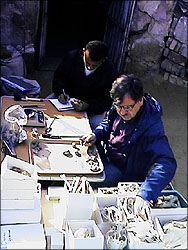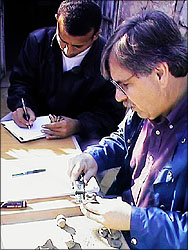
|
Newsflash
February 18, 1997:
Excavators Unearth Animal Bones
By Dr. Richard Redding, Faunal Analyst
 Our excavations at Giza are in an area where people lived, unlike the pyramids,
which is where the pharaohs were buried. As a result, we find the garbage
associated with everyday life, which may not sound romantic, but allows us to
build up a picture of the daily routines of the workers who built the pyramids.
The most common remains are pieces of broken pottery (pot sherds) but a close
second are animals bones. The study of the animal bones from Giza will provide
us with a glimpse of the diet of the people who lived around the pyramids as
well as insight into the economy that was the base for pyramid construction.
Our excavations at Giza are in an area where people lived, unlike the pyramids,
which is where the pharaohs were buried. As a result, we find the garbage
associated with everyday life, which may not sound romantic, but allows us to
build up a picture of the daily routines of the workers who built the pyramids.
The most common remains are pieces of broken pottery (pot sherds) but a close
second are animals bones. The study of the animal bones from Giza will provide
us with a glimpse of the diet of the people who lived around the pyramids as
well as insight into the economy that was the base for pyramid construction.
The most common animals in the site will be the domestic cattle, sheep, goats
and pigs. By identifying the animal bones we will be able to determine in what
proportions the animals where eaten. How many cattle were eaten for each
sheep, or for each pig? Many of the bones will provide us with information on
the age of the animal when it was killed. Using this information we will
construct "survivorship curves" for each species (cattle, sheep, goats and
pigs) that describe the pattern of animal slaughter. Were most of the cattle
killed young or old? Some bones can be sexed. This information will be used
to estimate a sex ratio for each species. Were most of the cattle killed males
or females? All of this information allows us to reconstruct how the ancient
Egyptians made decisions about herding their animals and how they controlled
each species.
 Another source of information on domestic animals is the relative proportion of
the different body parts. Are we finding the body parts in the same proportion
as they are found in a complete skeleton or are certain parts missing? This
type of information helps understand how domestic animals may have been
distributed. Did everyone get their own animals and butcher them or were there
separate butchering areas?
Another source of information on domestic animals is the relative proportion of
the different body parts. Are we finding the body parts in the same proportion
as they are found in a complete skeleton or are certain parts missing? This
type of information helps understand how domestic animals may have been
distributed. Did everyone get their own animals and butcher them or were there
separate butchering areas?
We will find the bones of fish and bird in the excavations. The species and
body part distributions will be studied. Were the fish caught and eaten
locally or were dried fish available to the inhabitants? How important were
fish and birds in the diet?
Our goal in studying the animal bones from Giza is to learn how food resources
were obtained and organized at the pyramids. The information from Giza will be
compared with the information on animals from an Old Kingdom village site in
the Nile Delta, Kom el-Hisn. Together these two sites should provide us with an
understanding of a critical aspect of the Old Kingdom economy - how food
production was structured and controlled. Without structure and control, the
pyramids could not have been built.
(previous newsflash)
(table of contents)
Photos: Carl Andrews
Pyramids Home | Pyramids | Excavation
Contents | Mail
|